When first diagnosed with gastritis, most people don’t even know where to begin. A lot of times, doctors briefly list some foods you can eat and some you should avoid, prescribe proton pump inhibitors, and antibiotics if you gastritis is caused by a H. pylori infection, and you’re on your way. It’s not until you get home and think about eating something that you feel you have no options and wonder what you could possibly eat to not make your symptoms flare up.
Do you even remember at that point what your doctor told you you can eat and what not? What about the foods nobody told you anything about?
Unfortunately, when it comes to gastritis treatment, there is a disproportionate interest in diet versus medication. That is, you will surely get a prescription for proton pump inhibitors and also antibiotics in case of a Helicobater pylori infection, but not a comprehensive list of all the problematic foods that could flare up your gastritis, even the ones that are otherwise healthy – just not for gastritis. Maybe even more important, you aren’t told what exactly you can eat with gastritis. Does this sound like your experience too?

And then you go online. And you find all of these articles about gastritis and what you can eat and what you can’t eat with the condition. And there is a lot of conflicting information. Which makes sense considering most of these articles are written by people who haven’t experienced gastritis themselves. Or worse, you’ll find plenty of articles recommending some of the same aberrant foods for getting rid of gastritis, such as garlic or ginger or turmeric or apple cider vinegar which, let’s face it, is regarded as some type of panacea these days.
If you too have been fighting a lengthy battle with gastritis, here is the big secret: if you want to relieve gastritis pain and other symptoms, heal your stomach lining and cure your gastritis permanently, a bland diet is the solution (fully recovered ex-gastritis sufferer here!). See below my tried and tested list of what to eat and not to eat for gastritis.
What to eat for gastritis
- Bland, absorbing foods such as refined cereal grains.
- Eggs of any kind in moderation, boiled or otherwise cooked, without oil or other type of grease.
- Lean meat, ideally boiled, grilled or cooked without grease (chicken, white fish).
- Boiled/steamed vegetables, mainly root vegetables and some leaf vegetables.
- Limited amounts of raw nuts and seeds.
- Limited amounts of selected fruits, boiled/stewed, without skin.
- Herbal tea for digestive issues.
- Certified raw honey or sugar as sweeteners.
What not to eat for gastritis
- Processed foods of any kind.
- Fatty foods, oily foods, fried foods.
- Spicy foods or foods that are heavily seasoned.
- Red meat, oily fish, fresh and canned.
- Most vegetables other than root vegetables and some leaf vegetables.
- Citrus fruits and most fruits, especially fruits that are meant to be eaten with skin.
- All unripe or underripe fruits.
- Fruit juices and vegetable juices.
- Pickled fruits and vegetables.
- Fermented, acidic, aged foods and beverages.
- High-fiber foods, especially when eaten in large amounts.
- Specific problematic foods: chocolate, coffee, alcohol etc.
- Sodas or soft drinks, even sparkling water.

Best gastritis foods to eat
- Refined grains: white bread, white bread toast, white rice, white pasta.
- Polenta made from plain corn flour or maize flour, salt and water.
- Refined grains-based products: rice crackers, plain or salted wheat crackers etc.
- Selected root vegetables (cooked): orange carrots, red carrots, yellow carrots, purple or black carrots, white carrots, parsnip, turnips, celeriac or celery root (caution: celeriac can cause allergic reactions), even potatoes and possibly also sweet potatoes, red and yellow beets, turnip or rutabaga.
- Selected leaf vegetables (cooked): spinach, kale, collard greens, beet greens, turnip greens, dandelion greens, sorrel, patience dock etc.
- Other vegetables: zucchini, mushrooms.
- Eggs including, chicken eggs, quail eggs, duck eggs, turkey eggs, goose eggs, ostrich, pheasant, peahen or other varieties of eggs, depending on tolerance. Ideally boiled, baked, poached or scrambled, but with no grease.
- Lean meat, mainly chicken meat such as ground chicken meat, chicken legs etc., but not organ meat such as liver. Turkey may be tolerated well too, depending on the person.
- White fish such as cod fish, hake, haddock, gilt-head bream (orata), merling (whiting) etc. Ideally boiled, steamed, but also baked or grilled, so long as no grease is used.
- Seafood such as crab meat, lobster or even shrimp.
- Limited amounts of raw nuts and seeds, including English walnuts, black walnuts, purple or red walnuts, cashews, hazelnuts, pecans, almonds, sunflower seeds, pumpkin seeds etc.
- Limited amounts of cooked fruit without skin, consumed infrequently. Examples: boiled or stewed pears, apples, quinces, Chinese quinces.
- Occasionally, some raw fruits, but in very small amounts: figs, lychee (litchi), rambutan, watermelon, persimmon (kaki), cherries, red, yellow, purple and black raspberries, blackberries, boysenberries, white, pink, red and black mulberries, blueberries, honeyberries (blue honeysuckle), ripe bananas.
- Herbal teas for digestive health (no teas with caffeine, including white, black and green tea or oolong tea).
- Raw, certified, organic honey, whether manuka or another kind. But make sure to check for allergies first.
- Fresh extravirgin olive oil or other cold-pressed oils of your choice for seasoning food , but in extremely small amounts. See my 1 week gastritis diet plan with menu examples and a detailed list of tips and advice to help you better manage your gastritis diet and achieve healing.
Considerations:
- Note 1: The bulk of a gastritis diet is made up of absorbent foods such as white rice, pasta, bread or polenta. Next in line are lean meat, white fish, eggs and selected vegetables. Nuts, seeds and cooked fruits are only eaten in limited amounts, small servings 2-3 times a week tops.
- Note 2: All vegetables need to be cooked, ideally boiled or steamed. Peeling can help remove fiber and make the vegetables even easier on the stomach.
- Note 3: Fruits are also best cooked and consumed without skin, and only in very small amounts. Fresh fruits may not be tolerated at all for some time, depending on how severe the gastritis. Not everyone with gastritis tolerates raw fruit in their diet, no matter how limited and infrequent the intake. If your gastritis is bad, avoid all raw fruit and only have some stewed fruit occasionally, at least until you’ve been on the diet for a few weeks and are feeling better.
- Note 4: Not grease should be used in preparing food to reduce acidity, whether grains, meat or eggs.
- Note 5: It helps to not drink liquids with a meal, but half an hour before or after a meal.
- Note 6: Never lie down after eating. Ideally, eat 2-3 hours before you go to bed.
- Note 7: And the most important rule of all: if you don’t feel good after eating a certain food, eliminate it from your diet because it’s just not good for you. Find out more of my tips on how to eat for gastritis.
Worst gastritis foods to eat
- Processed foods, including cold cuts or luncheon meats, sausages, chips, crisps, candy, ice cream, pie, cake, cookies or other sweets, frozen meals, chocolate spread, chocolate bars, commercial jam, whipped cream etc.
- Red meat such as game, pork, beef, veal etc. and organ meat (liver).
- Oily fish such as salmon, tuna, sardines, trout, swordfish, mackerel.
- Canned fish, especially fish canned in oil (olive oil, sunflower oil, rapeseed oil), tomato sauce, lemon etc.
- Aged cheese, both hard and semi-hard cheeses such as Parmesan, Havarti, Cheddar, Gruyere, Gouda, and soft cheeses such as Brie, Camembert. Brined cheeses such as feta, halloumi or telemea and processed cheeses such as processed mozzarella or processed cheddar.
Note: Fresh milk cheeses tend to upset gastritis less, but only if consumed in small amounts infrequently. - Vegetables except for selected root and leaf vegetables mentioned above, especially cabbage family vegetables (white, green, red and purple cabbage, broccoli, cauliflower) and high-fiber legumes (beans, peas, chickpeas, lentils).
- Potentially problematic vegetables that may not be tolerated by some in gastritis: potatoes, sweet potatoes (especially fried), pumpkin (very high-fiber), eggplants, cucumbers (fresh and pickled), but also tomatoes and tomato sauce, juice and paste and even corn.
- Fruits except for selected fruits mentioned above.
- Unripe fruits (e.g. unripe green bananas) and fruits that are eaten raw, with skin (e.g. raw apples, plums).
- Potentially problematic fruits: pineapple (contains bromelain), papaya (contains papain), bell peppers (green, yellow, orange, red, purple, black, striped bell peppers), hot chili peppers, acidic citrus fruits (lime, lemon, sweet and bitter orange, yuzu, mandarin, tangerine, grapefruit etc.), strawberries, cranberries.
- Spices and seasonings: hot chili peppers, ginger, turmeric, wasabi, horseradish, mustard, white and red garlic, spring garlic, chives, bulb onions (white, yellow, red, purple), shallots, spring onions or green onions, leek, sweet and hot paprika, garlic powder, onion powder.
- Fruit juices, vegetable juices, carbonated soft drinks (soda), coffee, caffeinated beverages, energy drinks, caffeinated teas (green tea, oolong tea, black tea, white tea), peppermint, spearmint tea and even carbonated water in some instances.
- High-fiber foods such as grains (e.g. whole wheat, oatmeal), legumes (e.g. lentils, chickpeas, beans).
- Fermented and acidic milk and milk products (e.g. soured milk, buttermilk, yogurt, drinkable yogurt, kefir, sana).
- Pickled fruits and pickled vegetables, vinegar.
- Alcoholic beverages.
- Cocoa, hot cocoa, chocolate etc.
- Oil roasted nuts and seeds and fried or oil-roasted snacks.
- Fats in large amounts: oils, butter, margarine, mayonnaise, lard etc.
Conclusion
If you too are working relentlessly to get rid of your gastritis but despite keeping to a strict diet you’re not seeing results, then it could be worth it to take a look at my comprehensive lists of the best foods to eat for gastritis and the most important foods to avoid. Keeping to a strict diet that consists of bland cooked foods that are easy to digest reduces strain on the stomach and helps reduce stomach acidity which helps the stomach lining heal. Over the course of a few months, a good diet plan helps you get rid of gastritis and feel better and healthier. The important thing is to remember to adapt any and all dietary recommendations to your own situation and discontinue eating anything that doesn’t make you feel good.
